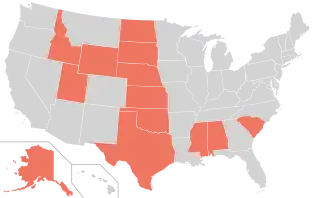Blue wall (politics)
"Blue wall" is a term used by political pundits to refer to 18 U.S. states and the District of Columbia that the Democratic Party consistently won in presidential elections between 1992 and 2012. George W. Bush, the only Republican president elected during this time, was able to narrowly win the electoral college in 2000 and 2004 only by winning states outside of the blue wall.

During the 2016 presidential election, many political pundits speculated that the "blue wall" made Hillary Clinton a heavy favorite to win the electoral college.[1][2] However, Republican nominee Donald Trump was able to narrowly achieve victories in the three blue wall states of Michigan, Pennsylvania and Wisconsin, as well as an electoral vote from Maine, a fourth blue wall state. He was consequently elected president with 306 electoral votes (excluding two faithless electors).
In the 2020 United States presidential election, Democratic nominee Joe Biden defeated President Trump by reclaiming Wisconsin, Michigan, and Pennsylvania for his party.[3] Trump's lone breakthrough in the "blue wall" in 2020 was the one electoral vote from Maine, which he again won.[4]
The term "red wall" (or "red sea") is less commonly used to refer to states that Republicans have consistently won in previous election cycles. However, these states represent significantly fewer electoral votes than the blue wall. These terms refer to the colors that have become associated with the Democratic and Republican parties, respectively, in the twenty-first century.
Origin
Ronald Brownstein claims to have coined the term "blue wall" in 2009.[5] After the 2012 presidential election, Paul Steinhauser called "blue wall […] the cluster of eastern, Midwest and western states that have traditionally gone Democratic."[6] The earliest description of the forces creating the blue wall comes from a Houston Chronicle blogger, Chris Ladd.[7] A Republican, Ladd wrote in November 2014 that the seemingly impressive Republican win in the 2014 mid-term elections had overshadowed another trend apparent in the results – a demographic and geographic collapse. The blue wall was a Democratic demographic lock on the Electoral College resulting from the Republican Party's (GOP) narrowing focus on the interests of white, rural, and Southern voters. Ladd's analysis became popular when MSNBC commentator Lawrence O'Donnell featured it on a post-election episode of his show The Last Word with Lawrence O'Donnell.[8]
A similar "red wall/sea", behind which lie states solidly Republican, has also been posited to exist. But, having fewer votes, it would be theoretically easier for a Democratic presidential candidate to win without breaching it, as had been done in 2012.
States behind the blue wall
Behind this "blue wall" lay states, many carrying a relatively high number of electoral votes, which appeared to be solidly behind the Democratic Party, at least on the national level, and which a Republican presidential candidate appeared likely to have to write off, seeking a total of 270 electoral votes from other regions. States behind this wall lay generally in the Northeastern United States, and the West Coast of the United States, and included some of the Great Lakes states. In each of the 6 presidential election cycles prior to 2016, the Democratic Party had won 18 of these states (as well as the District of Columbia), totaling 242 of the necessary 270 votes need to win. The "big three" Democratic stronghold states include California, New York, and Illinois.
States falling behind this blue wall generally included those the Democrats had carried since the 1992 presidential election until the 2016 presidential election[6][9] that included (in order of decreasing population and followed by current number of electoral votes): California (55), New York (29), Illinois (20), Pennsylvania (20), Michigan (16), New Jersey (14), Washington (12), Massachusetts (11), Maryland (10), Minnesota (10), Wisconsin (10), Oregon (7), Connecticut (7), Hawaii (4), Maine (4), Rhode Island (4), Delaware (3), and Vermont (3), as well as Washington, D.C. (3); this is a total of 242 votes. The last time any of these states cast their votes for the Republican presidential candidate before 2016 was when George H. W. Bush beat Michael Dukakis in 1988 and carried California, Illinois, Pennsylvania, Michigan, New Jersey, Maryland, Connecticut, Maine, Delaware, and Vermont. New York, Washington, Massachusetts, Oregon, Hawaii, and Rhode Island have voted Democratic since Ronald Reagan's landslide in 1984. One of these states, Minnesota, has not been carried by a Republican presidential candidate since 1972. (The District of Columbia has voted for the Democratic candidate in every election since it was admitted to the electoral college for the 1964 election.)
2016: Demise of the blue wall
The Democrats' "lock" on these states had been called into question between 2012 and 2016, as several had been competitive in recent elections, and many had Republicans currently holding elected statewide office, generally either senator or governor.[10] Blue wall states with a Republican senator included Pennsylvania, Wisconsin, and Maine. Those with a Republican governor included Massachusetts, Maryland, and Vermont. In addition to these 18 states, three others, Iowa, New Mexico, and New Hampshire, had only voted for the Republican once in the same 6 election cycles, giving their votes to George W. Bush in either 2000 or 2004, whilst Oregon saw Bush lose by only 7,000 votes in 2000. If included in the total, the votes behind the blue wall numbered 257, just 13 short of what is needed to win. In 2016, the blue wall showed some cracks, and went down from 242 electoral votes to 195. Some in the mainstream media did, however, suspect the Democrats might lose Pennsylvania.
Nate Silver had criticized the idea of the blue wall, pointing to a larger "red wall/red sea" of states that voted Republican from 1968 to 1988. He argued that the blue wall simply represented a "pretty good run" in elections, and that relatively minor gains in the popular vote could flip some of its states to Republican.[11] This was seen in the 2016 election, where voters from manufacturing states traditionally behind the blue wall voted for Donald Trump, providing him the victory in Pennsylvania, Wisconsin, Michigan, and Maine's 2nd congressional district.[12] Others have also posited that the states of Michigan, Wisconsin, and Pennsylvania had never definitively been "safe" for the Democratic Party, citing the close margins in those states in the 2000 and 2004 presidential elections and opining that the outsized margins of victory secured by Barack Obama in the elections of 2008 and 2012 may have created a false impression of their safety for Democratic candidates.
2020: Resurgence of the blue wall
During the 2020 United States presidential election, Democratic nominee Joe Biden won the states of Wisconsin, Michigan, and Pennsylvania, however only by 1–3 point margins, which put the states well within reach for future elections, putting the new "blue wall" in jeopardy and negating its safe blue status.[13] Biden also broke into the red wall by winning Arizona, Georgia, and the 2nd congressional district of Nebraska.[14][15][16] However, Maine's 2nd congressional district voted for Donald Trump.
In many ways, the blue wall has not died, but rather shifted in recent years from containing all the states that John Kerry won in 2004 (with the exception of New Hampshire), and instead replacing Wisconsin, Michigan, and Pennsylvania with New Mexico, Colorado, and Virginia. While they have only been carried by a democratic nominee for four straight election cycles, Joe Biden won all three of those states by more than 10% in 2020, and the demographic changes in all three of those states continue to bolster the strength of democrats in those states.
Red wall/sea

The states which Republicans have won in the last eleven elections (from 1980 to 2020) include Texas (38), Alabama (9), South Carolina (9), Oklahoma (7), Mississippi (6), Utah (6), Kansas (6), Nebraska (4) (but not Nebraska's 2nd congressional district), Idaho (4), South Dakota (3), North Dakota (3), Alaska (3), and Wyoming (3), giving a total of 101 votes. States with a 10-out-of-11 (from 1980 to 2020) Republican record include North Carolina (15), Indiana (11), and Montana (3), whose 29 electoral votes added to the 101 of the preceding thirteen red sea states make for a total of 130 electoral votes. Much of the Southern United States are also probably safely Republican, as six other states, Missouri, Kentucky, West Virginia, Arkansas, Tennessee, and Louisiana (the six states totaling 48 electoral votes), from that general region have not voted for a Democrat since southerner Bill Clinton in 1996, and in the Deep South the Republican Party is dominant in statewide elected offices.
In presidential elections
Presidential votes in blue wall states since 1876:
- Key
| Democratic Party nominee |
| Republican Party nominee |
| Third-party nominee[lower-alpha 8] |
Bold denotes candidates elected as president
See also
Explanatory notes
- The District of Columbia did not vote in presidential elections until 1964, after ratification of the 23rd Amendment to the United States Constitution.
- Hawaii was not a state until 1959 and did not vote in presidential elections until 1960.
- Washington was not a state until 1889 and did not vote in presidential elections until 1892.
- Parker won seven of Maryland’s eight electoral votes, with the other going to Roosevelt, whose highest elector actually received 51 more votes than Parker’s
- Taft’s highest elector actually received 605 more votes than Bryan’s, but of the top eight electors six were pledged to Bryan.
- Clinton won Maine's statewide vote, but Trump won one of the state's four electoral votes. Since the 1972 election, Maine has awarded two electoral votes to the winner of the statewide popular vote, with one vote going to the winner in each congressional district.
- Biden won Maine's statewide vote, but Trump won one of the state's four electoral votes.
- These were all named nationally as the “Progressive Party”, though the 1924 version was not a continuation of the 1912 one.
References
- Goldmacher, Shane; Karni, Annie. "Hillary Clinton's path to victory". Politico. Retrieved 2019-02-17.
- Seitz-Wald, Alex (2016-05-06). "Analysis: 'Blue Wall' Gives Trump Little Room for Error". NBC News. Retrieved 2019-02-17.
- "'It's Such a Relief': Biden Voters Rebuild a Wall That Trump Smashed". The New York Times. Retrieved November 8, 2020.
- https://www.politico.com/news/2020/11/04/congressional-maine-nebraska-presidential-results-2020-433380
- "Clinton's Campaign Is Focused on Battleground States She Doesn't Really Need – The Atlantic". www.theatlantic.com.
- Steinhauser, Paul. "Holding Democratic 'blue wall' was crucial for Obama victory - CNNPolitics.com". CNN.
- Chris, Ladd. "The Missing Story of the 2014 Election". Houston Chronicle. Houston Chronicle. Retrieved January 14, 2017.
- "'The Last Word with Lawrence O'Donnell' for Monday, November 17th, 2014". News. NBC. Retrieved 2014-11-17.
- "Breaking Democrats' 'Blue Wall'".
- "Democrats say a 2016 electoral college "blue wall" means Republicans can't win. Wrong". 25 February 2015. Archived from the original on 22 March 2015. Retrieved 28 February 2015.
- Silver, Nate (12 May 2015). "There Is No 'Blue Wall'". FiveThirtyEight. Retrieved 21 March 2016.
- "OFFICIAL 2016 PRESIDENTIAL GENERAL ELECTION RESULTS, General Election Date: 11/08/2016". Federal Election Commission. 30 January 2017.
- UTC, NBC News Exit Poll Desk1d ago / 4:52 PM. "NBC News Exit Poll: How Biden rebuilt the Democrats' 'blue wall'". NBC News. Retrieved 2020-11-08.
- "Biden becomes the first Democrat to win Georgia since 1992, CBS News projects". CBS News. Retrieved 2020-11-16.
- "Biden wins Arizona, flips longtime Republican stronghold". Associated Press. Retrieved 2020-11-16.
- https://www.bloomberg.com/news/articles/2020-11-04/biden-wins-nebraska-s-2nd-congressional-district

